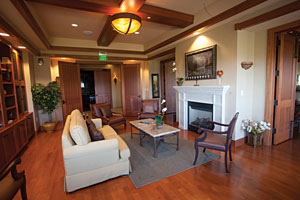Hardwoods in Green Building: Plantation-grown Eucalyptus Makes its Mark as a Versatile, Sustainable Exotic Species
Eucalyptus - A Sustainable Exotic Hardwood
Eucalyptus is the most commonly planted fast-growing hardwood in the world with more than 700 species in existence. Because of their fast growth, plantation eucalyptus trees were traditionally harvested as a source of pulp for the manufacture of tissue, printing and specialty papers. With demand escalating for rapidly replenishing and attractive hardwoods, eucalyptus plantations are increasingly being managed to produce solid wood for architectural finish products. Although eucalyptus is native to Australia and grows in the U.S.; it is in the tropical and subtropical regions where eucalyptus is not only prolific but also exhibits the strength and durability required for architectural finish applications.
Brazil is the top producer and exporter of eucalyptus roundwood and pulp. It was introduced into the country in 1910 and has thrived in the local environment; today there are around 5 million hectares of planted eucalyptus in Brazil. The growth rate of eucalyptus is unprecedented, with trees reaching the size needed for lumber in 14 to 16 years, ensuring reliable supplies for the foreseeable future. Some eucalyptus plantations are 11 times more productive on a per hectare per year basis when compared to a temperate forest, which may take 80 to 100 years to mature. A eucalyptus plantation can produce 30 times the volume of lumber per hectare per year when compared to an unmanaged temperate forest.
The key to this productivity has been a substantial investment in technological improvements in tree cultivation and manufacturing. Plantation-grown eucalyptus trees can now be selected, pruned and milled to provide straight boards with fewer knots than trees from unmanaged forests. It is the manual pruning or "lifting," that maximizes the clear wood in each trunk - in other words, limbs are removed, enabling the growth of tall trees with few knots. Because the trees come into the mill in a clearer, more uniform state, there is a high conversion of logs to clear lumber.
Characteristics
 |
Plantation-grown eucalyptus was used extensively throughout the Boulder Ridge Club House in San Jose. Photo courtesy of Boulder Ridge Country Club |
There are many eucalyptus species, the most common of which is Eucalyptus Grandis. A popular product on the market is a natural hybrid of Eucalyptus Grandis and Eucalyptus Urophylla, which is harder than the common grandis and offers wider flitch widths and fewer defects than many other species. Despite its short growth period, this eucalyptus compares favorably to mahogany and other tropical and domestic hardwoods in terms of appearance and strength, and is often valued by design professionals for conveying the feel and style of a more expensive wood at an affordable cost.
In appearance, plantation-grown eucalyptus has a grain that is straight, even and moderately coarse and a rich pink color. It is increasingly seen as a more cost-effective alternative to mahogany, which is among the most expensive woods due to its 50- to 60-year maturation process and its status now as a rare and protected hardwood.
Glenda Garcia, General Manager of the Boulder Ridge Golf Club in San Jose, California, a member of the International Furniture Designers Association and a Certified Designer in the state of California, selected plantation-grown eucalyptus for extensive use in the Craftsman-style clubhouse because of its similarity to mahogany and cherry. "The eucalyptus offered the widest range of colors, from a blond to walnut," says Garcia, who specified the wood for a variety of applications including interior walls, moldings, doors and the club bar. Lumber was shipped to out-of-state fabricators for the door and the bar. "We worked very hard on the stain color," says Garcia. "All the eucalyptus was hand-rubbed. It has a very warm feeling that people really respond to."
Eucalyptus is also becoming a replacement species for Brazilian cherry and kaya, which have been known to have questionable forestry practices. (Architects interested in keeping current on endangered timber species should consult the CITES lists on United Nations websites. In addition to Brazilian mahogany, some timbers to avoid due to their endangered status are: sapelee, wenge, ebony, and teak.)









